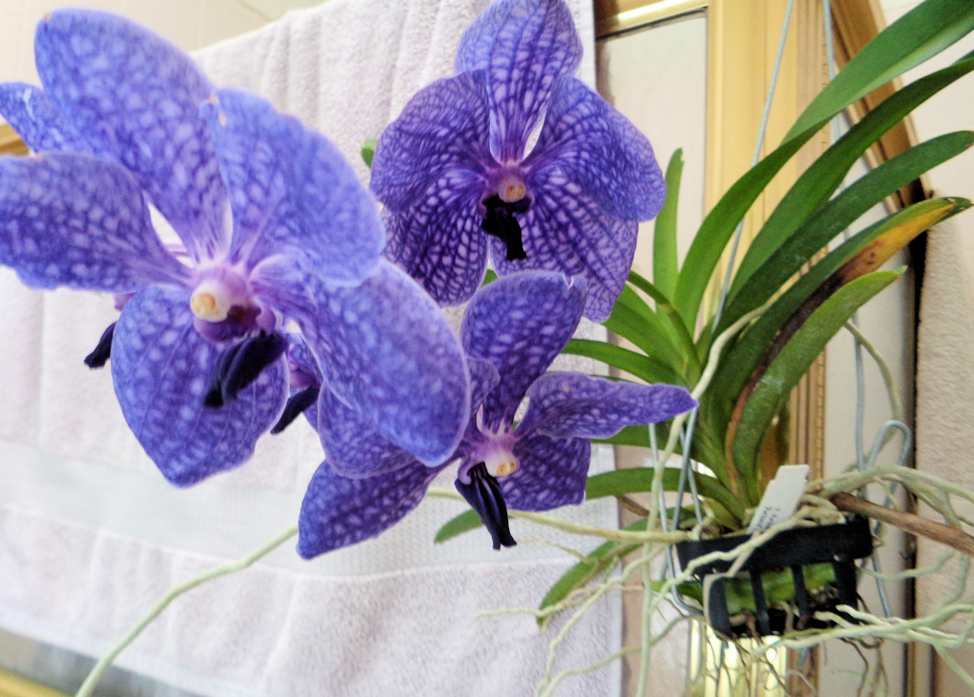
Orchids are not my forte, but I do know what I like and how to care for them. In the category of orchids, my first orchid of choice is the cattleya. My next orchid of interest is the Vanda orchid. Vanda orchids are amazing epiphytes that that produce both beautiful blooms and abstract plants with aerial roots and pleated leaves.
You have probably seen a Vanda orchid or two hanging in a garden center in the orchid section. At a glance, Vanda orchids look like they should not survive within their relatively spartan supports often consisting of a simple hanging wood or plastic basket minimally filled with an orchid mix. Vanda orchids are epiphytes, so sparse support is normal – just like they would be found in nature attached to a branch or tree crotch. These orchids come from tropical Asia where they would grow in varying degrees of sun/shade depending on the leaf-type. I have the strap-leaved type which does best in partial-shade. I have it outside under the dappled shade of a small tree where it seems to be thriving. I will watch night-time temperatures however to make sure they are protected or brought in when temperatures dip below fifty-five degrees F.
Vandas have exposed aerial roots well-adapted to life in the open air. During the warm active growing season, make sure that they are watered regularly providing that the aerial roots get to dry off to avoid rotting. During the winter, water less unless there is a warm sunny spell. Vanda orchids love humidity, so our Florida climate is the perfect environment to supply this during the warmer growing season. Fertilize with a 20-20-20 (or its equivalent) as per label directions once a week. Back this off to once a month during the cool season.
If you grow your Vanda in a basket, it can stay put for some time. Orchid mix in the basket will eventually break down at which point repotting is required – perhaps every two years in the spring. It can as simple as stepping up the smaller basket into a larger basket. Vanda orchids in pots can be stepped up into a larger pot using the readily available orchid potting mix. Premoisten the roots prior to repotting so that they are more pliable and less apt to break.
Expect your Vanda orchids to bloom best between spring and fall with long-lasting flowers, but a surprise flower stalk could appear randomly at any time. Vanda orchids can be enjoyed indoors while they are blooming – just provide for proper humidity with misting. Vanda orchids, and orchids of all types, make very nice Holiday gifts – something to consider this season! For more information on all types of orchids suitable for growing in our area, or to ask a question, please visit https://www.facebook.com/CharlotteMGLifeline/ . Ralph E. Mitchell is the Director/Horticulture Agent for the UF/IFAS Charlotte County Extension Service. He can be reached at 941-764-4344 or ralph.mitchell@charlottecountyfl.gov
Resources:
Vanda Culture Sheet (2021) American Orchid Society. https://www.aos.org/orchids/culture-sheets/vanda.aspx.
Booth, C. (2018) Blooming Vanda Orchids. Orchid Plant Care Info. https://www.orchidplantcare.info/blooming-vanda-orchids/
Chadwick, P. (2017) The Mystique of Tropical Orchids. Virginia Cooperative Extension – Piedmont County.
Jon (2020) Vanda Orchids: Beginner’s Care Guide & Pictures. https://brilliantorchids.com/vanda/.
Vanda (2016) Sundance Orchids. https://sundanceorchids.com/vanda/.
Grant, B. L. (2021) Vanda Orchid Info: How To Grow Vanda Orchids In The Home. Gardening Know How. https://www.gardeningknowhow.com/ornamental/flowers/orchids/vanda-orchid-care.htm.
 2
2
